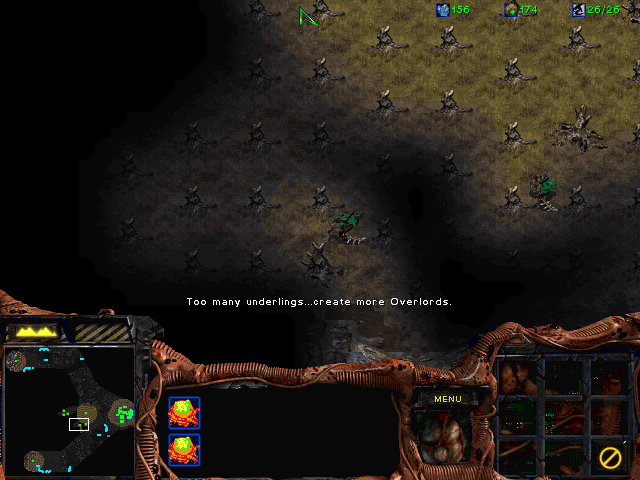novelty maps
Humans can play on crazy novelty maps where normal play does not work. We don’t have much trouble inventing special strategies for special maps. It’s a more extreme example of the human adaptability that we see in normal play. Bots have too much scripted behavior and can’t adapt at all to extreme novelty maps.
On the Blizzard map (2)Crystallis distributed with Brood War, the players start out separated by deep maze-like formations of 48-mineral blocks. Gas geysers exist, but they are also behind minerals, so before you can tech you have to mine a path through to a geyser. It’s a playable map, and maybe fun once in a while, but the strategies are vastly different than on a competition map (and terran would seem to have a big advantage). Crystallis seems to be well-known for crashing the BWTA terrain analyzer, so I expect many bots can’t play it at all. In this picture, look at the minimap to see how far the SCV’s have come from the original command center.

On (6)Crazy Critters, also included with Brood War, the map is so full of critters that it is difficult to place buildings. Units face big delays in moving as the pathfinder struggles with shifting critters. Here I opened with a forge and cannon to kill enough critters to make space for a gateway—I couldn’t find a way to place a gateway otherwise, but the random shifting of critters sometimes made room for smaller buildings, when the probe could arrive in time. The terran opponent is a built-in AI, which built a barracks in my base not because it wanted to proxy, but because that was the first open space it found. Also notice my soaring mineral count; I found myself unable to place enough buildings to spend my income. The map is frustrating to play on, but people can do it.

Less extreme concept maps from Blizzard include Blood Bath and Big Game Hunters. Both have been popular in their communities and people have developed specialized strategies.
Concept maps are rare in competition today, because they are difficult to balance, but they went through a period of popularity in pro tournaments around 2006-2008. Examples are Arkanoid, Demon’s Forest, Monty Hall, Plasma, Triathlon, Troy. Another interesting concept map is Fantasy, in which each quarter of the map has a different design, so that the map is not symmetrical and the game balance and strategy depend on the random starting positions. A lot of fun games with surprising strategies have been played on concept maps, and it would be cool if new ones were invented to meet today’s standards.
Here is Demon’s Forest as an example. Much of the 3-player map is covered by an array of doodads that block vision and sometimes bug out the movement of large units. Here an overlord off the top of the screen (visible on the minimap) provides vision of part of the array, and below two hydralisks are barely able to see beyond their snouts. I set up three other hydras in a triangle to show their lack of vision on the minimap.

Island maps were abandoned in competitive play after the early years, because they were imbalanced against zerg. But I wonder—today we know a lot more about how to balance maps. I don’t have the expertise to try it myself, but I would be interested to find out whether an island or semi-island map could be balanced today, using some variety of pro-zerg tricks: Smaller buildable areas, so that protoss and terran are forced to spread buildings across different areas; gas-only or low-mineral expansions, which zerg gets “for free” because zerg needs the hatcheries anyway; expansions or other areas with neutral creep colonies that zerg can use right off, but where other races need to kill the colonies first. The terran late-game information advantage could be reduced by putting a map doodad where the comsat would go in some expansion spots. There are more, you get the idea.
How do humans adapt their play to unfamiliar map features? I don’t know, and it seems like it must be complicated. I picked novelty maps as an extreme example, but humans (given time to learn) adapt their play to all map differences, and in fact to all aspects of the situation. Circuit Breaker and Fighting Spirit are both standard maps and play similarly, but features of the maps—like the mineral-only on Circuit Breaker and its position next to a low-ground expansion—make for important strategy differences. In an example of a different kind of adaptability, Last gained an advantage over Flash in their recent ASL match by recognizing Flash’s habit of building his barracks forward, to lift off and scout sooner. Last scouted for the forward rax and harassed the building SCV. I’m very interested in understanding that kind of human adaptability so that bots can eventually reproduce it. I think bots won’t catch up with humans strategically until bots can adapt broadly and deeply by learning over time.
How can a bot even get started on a map like Crystallis? Without being told, how could it figure out what to do to get gas? Next: Means-end analysis.
Comments
Jay Scott on :